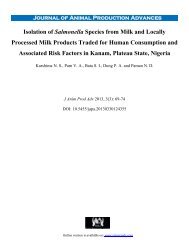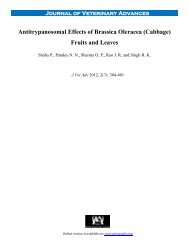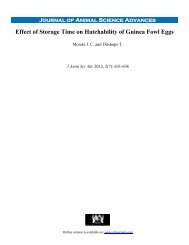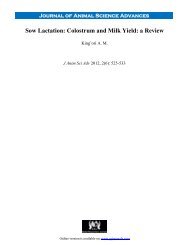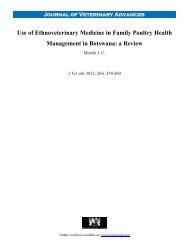You also want an ePaper? Increase the reach of your titles
YUMPU automatically turns print PDFs into web optimized ePapers that Google loves.
KING’ORI<br />
cuticle (Bell, 2007).Within the different layers are<br />
crystalline interfaces, hundreds of hidden fault lines,<br />
and thousands of pores (tiny tunnels which travel<br />
from outer to inner surfaces of the shell). The small<br />
amount of organic matter mostly consists of matrix<br />
proteins (mixture of proteins and polysaccharides<br />
rich in sulphated molecules) and shell pigment. The<br />
matrix proteins are critically important in<br />
determining the egg shell structure and serves as<br />
foundation for the deposition of calcium carbonate<br />
during the mineralization process (Burley et al.,<br />
1989; Lavelin et al., 2000; Gupta, 2008). Without<br />
the matrix proteins, the crystal structure would be<br />
too brittle to keep its form.<br />
The chicken eggshell is 95-97% calcium<br />
carbonate crystals, 0.3% phosphorous and<br />
magnesium and traces of sodium, potassium, zinc,<br />
manganese, iron and copper and organic matter<br />
(Arias et al., 2001; Nys et al., 2004; Hunton, 2005;<br />
Neospark, 2012)). The structure and composition of<br />
the avian eggshell serves to protect the egg against<br />
damage and microbial contamination, prevention of<br />
desiccation, regulation of gas and water exchange<br />
for the growing embryo, and provides calcium for<br />
embryogenesis. The eggshell should be as strong as<br />
possible to maximize the number of eggs reaching<br />
the consumer. No single factor is usually<br />
responsible for egg shell quality. Factors related to<br />
eggshell quality include nutrition (the nutrient<br />
balance and intake levels of the ration), health (the<br />
flock’s general health and previous health history),<br />
flock management and its age, environmental<br />
conditions and breeding (the strain and breed of the<br />
flock) along with other factors (Bell, 2007;<br />
Neospark, 2012). About 5-7% of eggs produced do<br />
not reach the consumer; 2-3% of the damage is due<br />
to problems during laying and 3-4% during the<br />
process after laying.<br />
Types of Shell Deffects<br />
They include shell thickness, gross cracks,<br />
hairline cracks, star cracks, misshapen egg, pimples,<br />
sand paper, pinhole, leatherly and glossy eggs. The<br />
complexity of structure of the shell gives rise to<br />
differences in breakage in eggs. The crack severity,<br />
shape and length are results of variations in the<br />
structure with fractures occurring at the points of<br />
least resistance (Bell, 2007). Shell deffects account<br />
for 0.5-5-6% of total production. Nutrition plays a<br />
key role in maintaining egg quality. The hens<br />
should be offered a balanced ration. Vitamin D,<br />
calcium, phosphorous, manganese, copper and zinc<br />
play a major role in maintaining the integrity and<br />
shell quality. Excess or reduced concentration of<br />
phosphorous, chlorine, or mycotoxin contamination<br />
affects the availability of calcium and vitamin D.<br />
Calcium and phosphorus balance is critical for<br />
proper egg production and eggshell quality. Layer<br />
ration should be formulated with correct amount of<br />
calcium and phosphorus (usually 3.5 - 4.0%<br />
calcium, 0.35-0.40% phosphorus).Numerous factors<br />
affect the functional quality of the egg shell mostly<br />
prior to egg laying. The thickness of the shell is<br />
determined by the amount of time it spends in the<br />
shell gland (uterus) and the rate of calcium<br />
deposition during shell formation. If the egg spends<br />
a short period in the shell gland, the thickness will<br />
be less (Neospark, 2012). Also, the time of the day<br />
when the egg is laid determines the thickness of the<br />
shell. In general, the earlier in the day or light<br />
portion of the photoperiod, the thicker the shell will<br />
be. Intestinal absorption of calcium in the diet is<br />
about 40% when the shell gland is inactive, but<br />
reaches 72% when active. This time closely<br />
coincides with late afternoon or the dark hours for<br />
the layer. Having higher calcium levels in the gut<br />
during this time is important to ensure calcium is<br />
being taken from the diet and not bone.<br />
Shell quality affect consumer appeal,<br />
packaging, egg breakage, storage/shelf life, and<br />
hatchability (Rogue et al., 1994; King’ori, 2011).<br />
An egg shell that is smooth is desirable because<br />
rough shelled eggs break more easily. Large sized<br />
eggs usually break more easily than small ones<br />
because the hen is genetically capable of placing<br />
only a finite amount of calcium in the shell<br />
(Neospark, 2012). Reduction in shell quality lowers<br />
egg shelf life, hatchability and increases breakage.<br />
Shell thickness and porosity regulate the exchange<br />
of carbon dioxide and oxygen between the<br />
developing embryo and the air during incubation<br />
(Rogue, 1994). Shell thickness has significant effect<br />
on moisture loss during storage and incubation<br />
(Bennett, 1992). Thin shelled eggs loose more<br />
moisture than do thick –shelled eggs, causing<br />
352 J. Anim. Prod. Adv., 2012, 2(8):350-357




